|
Part One
Sugiura Yasuyoshi
In Clay, A Flower Blooms
For Part Two, Click Here
Quite a few English readers have shown interest with the news of my recent interviews with both Kaneko Kenji (Chief Curator of the Crafts Gallery, Tokyo National Museum of Modern Art) and conceptual potter Sugiura Yasuyoshi.
I intentionally chose to interview these key figures back to back, as their theories on yakimono shed great light upon on the following questions: Where have we been? Where are we now? And where are we going?
Both Kaneko and Sugiura are leading figures in Japanese ceramics today, and represent two different sides of the pendulum: the perspective of the pundit, and the perspective of the potter. It is true that they differ on many things, but they also coalesce upon several key points as well. It is all about reading the fine print, I suppose. Try squinting.
You may not agree with everything they say. You might turn your nose and think, "that smelled rather odd." But at the end of the day, I believe that there is no denying the fact that what they say, at the very least, begs for debate. And isn't that one of the privileges of loving something passionately?
Sugiura-san's interview has been translated in a literal, rather than strict, light. Furthermore, the interview (a "super-size me" three hours of non-stop chatter) has been separated into two installments (part two will come next week). Kaneko-san's interview will be introduced soon thereafter. The Japanese-language interviews, in their entirety, can be viewed at yakimono.net (the Sugiura interview is here).
The ideas of our times are within your hands. Embrace them, before the opportunity slips through your fingertips.
In Clay, A Flower Blooms
In the rubble of nameless pebbles (the "Ceramic Stones" series), lies self-expression. In sculpted boulders (the "Ceramic Boulders" series), is instilled the virility of mountains. And from clay earth, blooms a vivid ceramic rose ("Ceramics of Natural History" series). Within the malleable possibilities of clay, ceramicist Sugiura Yasuyoshi instills a unique sensibility. In the sensual strings of his imagination, I saw cycles of Earth that have not changed from the days of her conception. And I was pulled in. Ceramics is clay. Clay is earth. And earth is this planet we share with each other. To materialize a world that can only be expressed through clay, and to create a world that has meaning because of clay: in the conceptual purity of Sugiura-san's ideas, the world turns once more.
 |
Piece by Sugiura Yasuyoshi
From "Ceramics of Natural History" series II
Shattering the Paradigms of Contemporary Yakimono
(S = Sugiura Yasuyoshi; W = Wahei Aoyama)
W: You currently reside in Manazuru, Kanagawa Prefecture, but do you ever return to Tokyo, your hometown?
S: Well, I hardly return to Tokyo these days. I don't enjoy being in crowds. They tire me out, so I only return when I have exhibitions. I don't even go to friends' exhibitions anymore, as it seems my loyalties have run dry as of late (with a tart laugh).
W: Do you ever return to your alma mater (Tokyo Geidai, or The Tokyo National University of Fine Arts and Music, the undisputed number one arts school in Japan)?
S: Not really, as I don't know anyone there. Yes, Shimada Fumio-kun (fellow graduate of Tokyo Geidai and currently head of the ceramic art department) is there, but I don't really hang out with him. But I do get current students to help me out from time to time when I have an exhibition. But honestly, I sometimes wonder if they have any interest in my work, as they seem quite passive. Maybe they're just being polite.
W: Or maybe they're all nervous to be in front of a sempai (elder alumnus).
S: Rather unlikely (slightly embarrassed laugher ensued). But you know, when I was working as a visiting artist at the Shiga Togei no Mori Museum for a month and a half, I got quite close with the kids there. Well, being with a group of people for a month and a half, I guess it's only natural that a bond forms. I even felt as if I wanted to introduce these young potters to galleries in Tokyo.
W: How do you see the current yakimono scene?
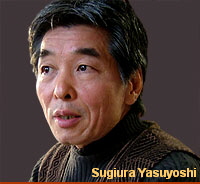 S: Hmm. I think that since the bubble burst (early 1990s), there has yet to arrive a new and vibrant yakimono theory. That's how I see it. Even the people who buy or enjoy viewing my work seem to have lost a sense of direction. So after the bubble bursting, at least in regards to theory, I think we've plunged into the doldrums. But as long as we get a point in the right direction, I don't think we're in a particularly bad day and age. Look at the younger artists: the energy of the next generation, I think, is building up, and is ready to be heard. S: Hmm. I think that since the bubble burst (early 1990s), there has yet to arrive a new and vibrant yakimono theory. That's how I see it. Even the people who buy or enjoy viewing my work seem to have lost a sense of direction. So after the bubble bursting, at least in regards to theory, I think we've plunged into the doldrums. But as long as we get a point in the right direction, I don't think we're in a particularly bad day and age. Look at the younger artists: the energy of the next generation, I think, is building up, and is ready to be heard.
W: In the Eighties, sculptural artists like yourself, Akiyama Yo and Hoshino Satoru entered and made the art scene, especially in a movement called "Claywork," a title coined by prominent ceramic critic Inui Yoshiaki (which alluded to works that were a gradual evolution from the conceptual works of the Sodeisha in the 1960s and 1970s. Claywork were larger clay pieces that were often based on concepts, did not have functionality, and usually fitted an installation format similar to fine art). Yet when we entered the Nineties, perhaps "movements" in general grew harder and harder to discern. With this in mind, saying "I don't think we're in a particularly bad day and age" do you mean we're returning to a "better age" in ceramics?
S: Well, I am essentially saying that we might have entered a "better age." But you also can't deny the fact that in today's ceramic world, the artists who had been fighting at the cutting edge of avant-garde pottery can't make a living by simply making conceptual pottery. Since they can't put bread on the table with their works, they have to resort to becoming university professors or finding other side positions. But if that's the case, they can't continue to completely focus their energies on pottery. In this event, it's considerably harder for artists to feel the "cutting edge" upon their skins.
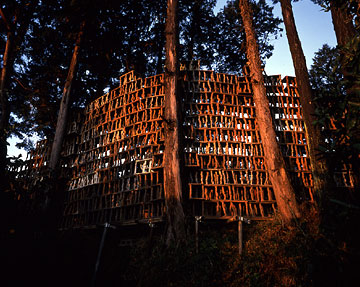 |
From "Ceramic Trees" series
Photo by Koike Koh
There has to be two spectrums: one focused on retail, the other focused on leading the way forward, while at the same time, continuing to retain both fans and collectors. In that respect, I think the direction of the entire yakimono community is blurred. I don't want to consider it an investment, but collectors used to collect contemporary pottery with the thought that it would be resalable at a higher value; yet today, there's even less of a guarantee, and collectors start to run towards a safer gamble: antiques. This shift begins to deplete the number of buyers in the contemporary realm, and this in turn depletes the number of supporters of the avant-garde. With this, exhibiting a new series of works will be unprofitable, even for the media. Hence, the entire health of the yakimono community dwindles. In this predicament, potters turn to teaching or part-time jobs, and can't focus on their art. That's the scary bit for an artist. A "holiday" away from thinking about and making pottery.
Some of my contemporaries know they can't make a living, so they stop with their art and find a job, so that they can live through a bad age until the economy picks up. But come on, if they quit now, their creative vitality just slips away.
W: I recently met a potter who made these wildly creative objet, but says he can't make a yen off of this kind of avant-garde work, so instead he makes functional vessels to make a living. But in such an age, it's then impossible for potters to focus their creative energies on the advancing of their art. They lack the freedom to elevate their artistic sensibilities, and in that regard, I suppose one can say that this is indeed a tough time for potters.
S: I'm not sure if it's an answer, and I'm sure that www.yakimono.net is broadcasting interesting ways of viewing yakimono in the modern age, but I think contemporary ceramic galleries in general need to find and focus on a central theme; without it, it'll be difficult to shatter the present paradigm we're in.
W: I completely agree. The Sodeisha are a good example, as they were a movement with an amazing cast of first-class potters who got together to push the envelope, and in the shadows, both the media and the gallery strongly supported their liberalism.
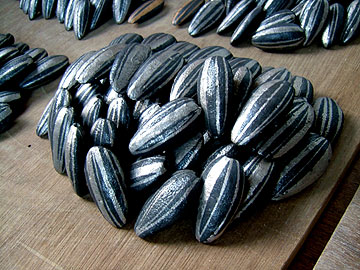 |
by Sugiura Yasuyoshi
Part of work from "Ceramics of Natural History" series II
S: Exactly, but you don't want to run towards just plain economic gain. Culture, and national heritage should also be expounded and built on. And even in regards to claywork, I think the theory in itself had a positive affect on the entire yakimono scene in general, as it widened the parameters of what yakimono could mean. Of course, today we see, like in the "craftical formation" theory of Kaneko Kenji, a tightening of those parameters, but I honestly think those boundaries should be wide and open.
W: I agree.
S: And here's another story. I think the "value" of a ceramic work should not be dictated by past accolades or prestige titles such as Living National Treasure, or comparisons with prices on past works. Value should be evaluated through the toils of an artist to create something beautiful, and the evaluation of that beauty by people who live in the present day and age as those artists. Collectors today have the privilege, or the right, to determine what is beautiful and what is not beautiful, as they can influence what will remain and what will not remain. In other words, collectors can create the scene by supporting today's artists. It is through the purchasing of works by contemporary artists that can help influence or "make" an art scene. Works from the past are novelty items. They are remnants of what past peoples considered beautiful at the time that they were made. In other words, the beauty within those works has already been determined. I'm not saying that a contemporary work will always be better than a work from the past. I'm trying to say that the works of contemporary artists, whether they be good or bad, are all reminders of the fact that we're living in the present, this moment, right now, today. Such works are born from our day and age. They are representative of us. And that should be invaluable in itself.
W: So in other words, what is important is the beauty that exists today, at this very moment.
S: It's like a democracy. We all have the right to participate in deciding what is beautiful. And that's part of the joy of collecting contemporary art. We have the chance to determine what will remain for future generations, what future generations may someday call "eternal beauty." Just consider music. You go to a concert, and enjoy and participate in the creation of live, fresh music, born that very moment in time. Or you can be content with picking up a CD and listening to pre-recorded music in the privacy of your own room. It's the same difference. And I personally believe the former is more exciting.
Within a Movement Shines a Concept in Clay
W: When Inui Yoshiaki labeled potters like yourself as part of his "Claywork Movement," did you really believe you were part of a movement, working in coordination with such artists as Akiyama Yo and Kato Kiyoyuki?
S: Actually, I did have a feeling that we were all working together, as we did have many group exhibitions with artists with similar mindsets. But I honestly didn't know that it was Inui-san who coined the term and tried to start something new. I remember he came to one of my very first shows during my Ceramic Stones phase, and after I received several consecutive awards at the time, I thought that there might be some unseen force at play. But I never really gave serious thought to it at all, as I never enjoyed being grouped under a label in the first place. In retrospect, I guess I might have played a nice pawn for the Claywork ideology. Pundits enjoy fitting their theories upon artists; often times having their own theories trump the very art they are critiquing. I always thought I was doing things that were different from what they were all talking about. There was once an exhibition in Yamaguchi in the 1980s titled "What Do You See in Large Yakimono." I exhibited a work, as well as Akiyama Yo and Nishimura Yohei. At that very exhibition, I first realized that my fellow potters had the same idea: to make large-scale works that were different from what had come before us.
W: So I suppose you were checking out other artists, and thinking that your fellow generation were thinking in the same way.
S: Yes. But with potters like Hoshino Satoru-san and Nishimura Yohei-san, they added even more conceptuality to the mix. They are both very clever, and could see pottery through conceptual ideals. I'm hardly that clever, as I'm more of a jock in regards to pottery. Originally, I had to physically toil and work to produce hundreds and hundreds of small clay rocks, to try and charge/capture as much energy as possible into each stone, and let each stone accumulate an energy that could only be produced by gathering all the stones en masse.
Potters in the 1980s had evolved from the potters in the 60s and 70s, as we didn't only dwell on materials, but we also dwelled on concepts as a point of growth. But what was most important, and what we didn't try to forget, was that the fundamental basis of our work was that we worked in clay. We were potters, first and foremost. Nishimura Yohei might be different. But for Hoshino-san, Akiyama Yo and me, we thought that clay as a material was the essential basis for our creativity.
W: In other words, clay is everything. Without clay, it no longer is yakimono. Clay is the starting point.
S: Exactly. But although that's what I had always felt, some critics viewed me as ignoring what "yakimono" or "clay" or "firing" were meant to stand for. They thought I was removing the processes behind the art. But that's not right. I wanted to take clay and turn it into a certain kind of ceramics. By firing clay, it turns into something unique, characteristic, eloquent and expressive. Something that could only be expressed through ceramics, and not any other material. Nor did I want to just free ride on clay textures that were relatively easy to produce through firing. I wanted to appeal to a trait of clay that was harder to see, and what could not be so readily visualized.
W: When I look at the works of contemporary sculptural artists, I sometimes tilt my head and ask, "Why did this artist bother to make this work in clay?" It is perfectly all right if a work is avant-garde, and I think it is perfectly all right if a work fits yo-no-bi (beauty within functionality). But I sometimes feel that many potters today use clay as a means to an end, rather than pottery being the end itself. They leave clay behind. Conceptual potters can often be blinded by their own concepts. But if that's the case, why don't they just go ahead and use other media, such as lacquer or metalwork? Why choose clay, if their concept comes before clay? I think Yagi Kazuo always had clay as his foundation. Clay was like the air he breathed; it was ever so natural, and was his fundamental starting point -- not the concept. That's why I can relate to your works as well. Take for example your Ceramics of Natural History series. In that series, you use clay to form flowers. But flowers, as well as all plants, are born from and grow in soil. Soil is earth, and so is clay. In other words, when you make a clay flower, I see a metaphor for life itself. And such a metaphor can only be expressed in clay, both conceptually and physically.
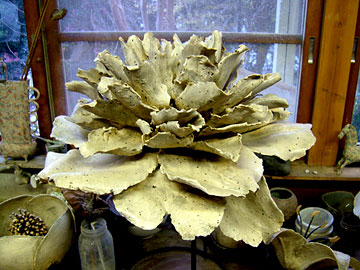
Work in Progress, by Sugiura Yasuyoshi
From "Ceramics of Natural History" series II
S: I think that if you try to express an idea, while at the same time trying to bring out the full potential of a material without being entrapped in the material, they can go hand in hand in making something beautiful. And what is most satisfying for me is when I can bring out both worlds through clay. What feels nearly perfect is that feeling I get when I can take clay and bring out its full clay flavor, while at the same time, bringing out the flavor in glazes. If I just said, "Hey, here's a flower I happened to make in clay," without being able to bring the depth of the material to life, then that clay flower can only be what it is: an artificial flower. Clay, I think, is the most important thing you can't leave behind.
End of Part One. Part Two next week, entitled "In Search of One's Self Through Clay" and "Ideologies of a Potter."
Lastly, yet another obituary.
Living National Treasure Kato Takuo (Important Intangible Property holder for Sansai wares) passed away at the grand age of 87 due to pneumonia, January 11th, 2005. Born in Tajimi, Gifu as the eldest son of Kato Kobei 5th (1893-1982), Takuo was also the 6th head of the Kobei Kiln. Although hailing from Mino, Takuo did not dwell upon the ceramic traditions of his locale (although he did occasionally produce Shino, Ki-seto, Setoguro and Oribe works).
Rather, it was his life-changing meeting with Persian lusterware that led Takuo on a life-long pursuit of its revival. He succeeded in the early 1980s and received critical acclaim for his achievements. Yet Takuo did not receive LNT status for this technique, as lusterware was not part of the ceramic heritage of Japan. Rather, Takuo also revived the ancient art of Sansai wares (three differently colored, glazed wares) from the Nara period, and it was this technique that brought him eventual LNT status. Highly influential and a wizard of glazing, Takuo's spirit lives on in his work, as well as in his son Kato Kobei 7th.
Click here for Part Two
of Sugiura Yasuyoshi Interview
See you next week.
Story by Aoyama Wahei
All photos on this page by Aoyama Wahei unless stated otherwise
PHOTO TOUR OF WORK BY
SUGIURA YASUYOSHI
Below Photos by Robert Yellin
From the 2004 Mitsukoshi Exhibition
 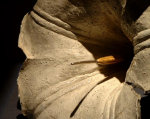
 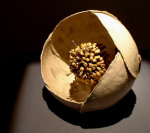
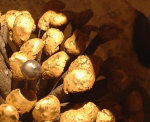 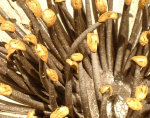

INDEX TO
ALL STORIES
by Aoyama Wahei
|